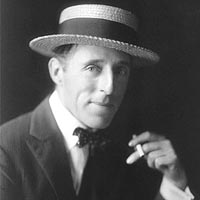Sunday November 15, 2009, 7:30 pm
Los Angeles Filmforum presents
D.W. Griffith in California, with talk by Tom Gunning
At the Echo Park Film Center

D.W. Griffith
1200 N. Alvarado Street (@ Sunset Blvd)
Los Angeles, CA 90026
213-484-8846
For reservations, email lafilmforum@yahoo.com
Note change in location!
For fans of early film, and of Southern California history! We’re delighted to host the internationally-renowned film scholar Tom Gunning, who will talk about Griffith’s time in California, and these selected, rarely screened films made in So Cal in the years before World War I. All in 16mm with live musical accompaniment by Cliff Retallick.
In 1910, retreating from the harsh East Coast winter which confined them inside the narrow limits of their NYC studio in a 14th st. brownstone, D.W. Griffith transported the Biograph film company to southern California. For the next four winters the company made over a hundred one reel (15 minutes) films in the area around Los Angeles, covering every genre in a range of locations: westerns in the deserts and hills; a caveman film in Griffith Park; tales of lost lovers by the seaside; Mexican dramas among the cacti. These brief films laid the foundation for cinema as a narrative art, but, even more, the displayed a beauty of landscape and detail that year later Griffith claimed Hollywood had completely forgotten. – Tom Gunning
Special Thanks to Tom Barnes for the silent speed projector and to all our print sources: David Shepard, USC Hugh Hefner Moving Image Archive, Academy Film Archives, and Budget Films.
Man’s Genesis (1912, 17 min)
Griffith took on the somewhat daring task of illustrating Darwin’s theory of man’s evolution with Bobby Harron as a cavemen who proves intelligence triumphs over brawn. With Mae Marsh
The New Dress (1911, 17 min.)
A psychological story of Mexican life showing Griffith’s genius for building a story around an object. With Dorothy West.
The Massacre (1914, 20 min)
A true epic in small form, showing Griffith’s ambitions to create a panoramic landscape of action. As he often did, Griffith showed how the American westward expansion destroyed the peaceful lives of Native Americans. With the magnificent Blanche Sweet and Wilfred Lucas.
The Unchanging Sea (1910, 14 min.)
Griffith used the seaside as a poetic motif to express longing and loss, combined with a deft use of parallel editing to express the cycles of life. With Mary Pickford and Charles West
The Sands of Dee (1912, 17 min)
One of Griffith most poetic films, based on a poem by Charles Kingsley, as Mae Marsh plays an abandoned lover who haunts the shore.
The Female of the Species (1912, 17 min)
A grim melodrama of survival in the desert in which women play out the central drama of jealousy and revenge (including a rather murderous Mary Pickford).
Tom Gunning is the Edwin A. and Betty L. Bergman Distinguished Service Professor in the Department of Cinema and Media at the University of Chicago. He is the author of the books, D. W. Griffith and the Origins of American Narrative Film: The Early Years at Biograph and The Films of Fritz Lang: Allegories of Vision and Modernity and of over a hundred essays , especially on early cinema and the avant-garde. He is currently a Visiting Scholar at the Getty Research Institute researching the theory and history of the moving image. http://humanities.uchicago.edu/cmtes/cms/faculty/gunning.html
D.W. (David Wark) Griffith (1875-1948)
Griffith was born in rural Kentucky to Jacob “Roaring Jake” Griffith, a Confederate Army colonel and Civil War hero. He grew up with his father’s romantic war stories and melodramatic nineteenth century literature that were to eventually mold his black-and-white view of human existence and history. In 1897, Griffith set out to pursue a career both acting and writing for the theater but for the most part was unsuccessful. Reluctantly, he agreed to act in the new motion picture medium for Edwin S. Porter at the Edison Company. Griffith was eventually offered a job at the financially struggling American Mutoscope & Biograph, where he directed over 450 short films, experimenting with the story-telling techniques he would later perfect in his epic The Birth of a Nation (1915). Griffith and his personal cinematographer G.W. Bitzer collaborated to create and perfect such cinematic devices as the flashback, the iris shot, the mask, and crosscutting. In the years following Birth, Griffith never again saw the same monumental success, and, in 1931, his increasing failures forced his retirement. Though hailed for his vision in narrative film-making, he was similarly criticized for his blatant racism. Griffith died in Los Angeles in 1948, one of the most dichotomous figures in film history. – from imDb, http://www.imdb.com/name/nm0000428/bio
This screening series is supported, in part, by the Los Angeles County Board of Supervisors through the Los Angeles County Arts Commission and the Department of Cultural Affairs, City of Los Angeles.
